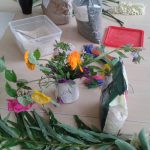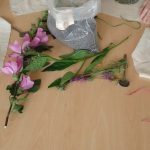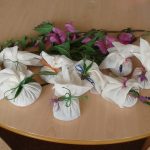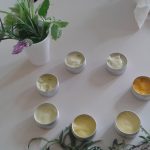We have recently been working with Anna Canning and Nicky Brownrigg of Flora Medica to deliver sensory healing workshops on hospital wards, and one in the Growing Space at the Community Gardens. These have been very popular with patients and staff, who have made bath/shower treats, body creams and lip balms for herbs and other ingredients such as oatmeal. Some of the herbs are picked fresh in the hospital grounds on the day of the workshop. The project is part of our Recovery Pathways programme, which is bringing a taste of the gardens to the patients and staff, in order to encourage them to experience all that the community gardens and other green spaces at the hospital have to offer. These DIY remedies/body care products include ointment, balm, hand cream, body scrub, bath treats, cough linctus, toothpaste.
Other activities on offer include:
Wild foods (simple shared seasonal dips, salads, soups)
Wild drinks (seasonal plant infusions, cordial making)
Environmental art – e.g. natural paints & pigments, pictures, species creatures, sunprints (cyanotype, using plants etc.)
Trees & their uses; tree ID, tree measuring, tree medicine
Willow crafts (e.g. picture frames, figures, dream catchers, lanterns, etc.)
Citizen science activities (e.g. wildflower ID, tree health, air quality, biodiversity survey, soil survey) using OPAL resources ( www.opalexplorenature.org )
Sounds & words: sound mapping, word games, stories, collaborative poems
Wild music: making simple instruments using natural materials – kazoo, whistle, etc.
Basic bushcraft: shelter building / knot tying / hammock; using a kelly kettle
Many plants have medicinal properties. Here are some that you may know already. But did you know that they are also good for the skin?
Oats: (yes, porridge!) Oats are not only good for your heart and digestion, oatmeal (medium) is great as a skin wash for helping us get rid of dead skin cells and avoid infection. It is also very soothing, nourishing and skin-softening. It is especially good for dry and irritated skin. Doctors prescribe a cream (“Aveeno”) made from oat extract for people with eczema.
Lavender – promotes relaxation, but is also soothing and antiseptic for the skin
Chamomile – people drink calming Chamomile tea to help them sleep or ease an upset tummy, but Chamomile is also a calming anti-inflammatory for the skin
Mint (e.g. peppermint) – as tea (or sweets!), mint is good for your digestion after a big meal, but it is also cooling for irritated skin; soothes bites and stings
Marigold – strong anti-infective (antiseptic, antiviral and antifungal properties)
Comfrey – (also known as “knitbone”) contains potent healing substance called allantoin; great for
cuts, grazes, bruises and sprains; safe to use on broken skin
Nettle – excellent anti-allergy properties; taken as tea and applied externally, nettle quickly helps calms allergic reactions like hives and hay fever
Willow – one of the plants that gave us aspirin, willow leaves are also antiseptic and useful in the bath for easing aches and pains






